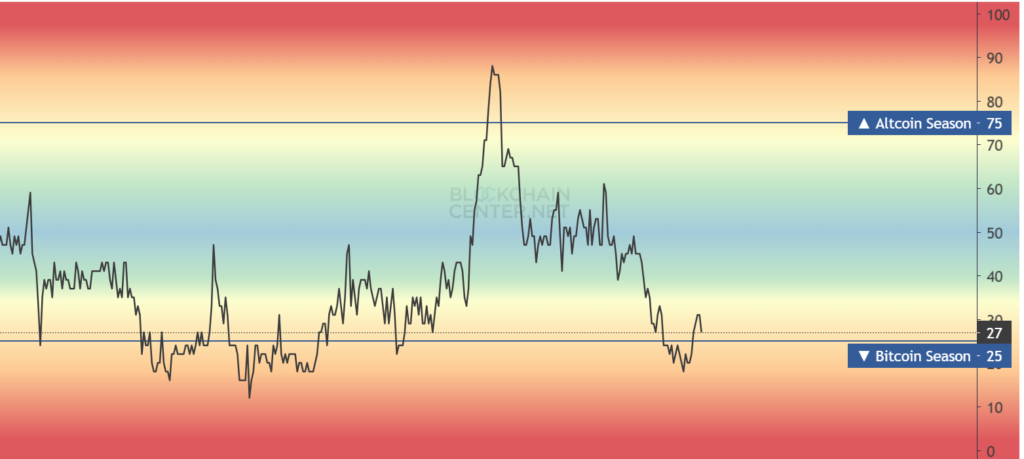The cryptocurrency market operates in cycles, and one of the most eagerly anticipated phases among traders and investors is altcoin season. Despite widespread predictions of a major altcoin boom in 2025, the Altcoin Season Index remains low, indicating that Bitcoin continues to dominate the market. Many experts had forecasted a strong altcoin performance this year based on trends observed in 2024. However, current data suggests otherwise. This article examines the reasons behind the delay, the factors suppressing altcoin growth, and how investors can strategically prepare for an eventual altcoin rally.
What is Altcoin Season?
Altcoin season, often referred to as “alt season,” is a period when alternative cryptocurrencies significantly outperform Bitcoin (BTC) in terms of price appreciation. This phase typically begins when capital shifts away from Bitcoin into smaller-cap cryptocurrencies, leading to rapid price surges in altcoins. But how can investors determine when altcoin season is starting? Here are some key indicators:
Signs of Altcoin Season:
- Altcoin Outperformance: This phase begins when altcoins experience substantial price increases relative to Bitcoin, often following a BTC peak and subsequent accumulation phase.
- Declining Bitcoin Dominance: A drop in Bitcoin’s market dominance signals capital rotation into altcoins.
- Bitcoin Halving Impact: The 2024 Bitcoin halving is expected to act as a catalyst for a potential altcoin rally in 2025 as funds transition from BTC into alternative cryptocurrencies.
- Altcoin Season Index (ASI): The ASI defines altcoin season as when 75% of the top 50 altcoins outperform Bitcoin over a 90-day period.
- Capital Flow Pattern: The typical progression sees money move from Bitcoin to major altcoins, followed by mid- and low-cap assets, presenting multiple profit opportunities at each stage.
- Emerging Sectors: The 2025 cycle is expected to be fueled by advancements in AI, DeFi, Web3, and real-world blockchain applications.

From: Block Chain Center
Why is the Altcoin Season Index Low?
1. Bitcoin’s Sustained Market Dominance
Bitcoin has continued to attract significant institutional investment, particularly following the approval of Bitcoin ETFs, which have funneled billions of dollars into BTC. This institutional preference for Bitcoin has maintained its dominance, preventing capital from flowing into altcoins.
2. Weak Performance of Altcoins
The Altcoin Season Index measures how many of the top 100 altcoins have outperformed Bitcoin in the last 90 days. With the index currently sitting at 27, it indicates that only 27 out of 100 altcoins have exceeded Bitcoin’s growth, suggesting that altcoins have yet to gain strong upward momentum.
3. Lack of a Strong Altcoin Narrative
Historically, altcoin seasons have been driven by distinct market trends:
- 2020: DeFi Boom (AAVE, UNI, COMP)
- 2021: NFT and Metaverse Hype (AXS, SAND, MANA)
- 2023: AI-Driven Surge (RNDR, AGIX, FET)
However, 2025 has yet to establish a dominant narrative. While meme coins and blockchain gaming projects have seen some traction, the broader market remains cautious, awaiting a compelling trend that could drive capital inflows.
4. Economic Uncertainty and Market Sentiment
Macroeconomic conditions, including inflation, interest rates, and global liquidity, significantly influence the cryptocurrency market. High interest rates tend to suppress riskier assets like altcoins, as investors remain wary and prioritize Bitcoin and Ethereum over smaller-cap projects.
5. Crypto Market Cycle Timing
The crypto market follows a cycle where:
- Bitcoin leads the initial rally with significant price increases.
- Large-cap altcoins like Ethereum (ETH), Solana (SOL), and Cardano (ADA) gain traction as capital shifts from BTC.
- Smaller altcoins see exponential growth once Bitcoin stabilizes.
At the start of 2025, Bitcoin experienced a sharp drop from its peak of $109,000 to $76,000. This correction significantly impacted altcoins, leading to substantial losses for many investors. However, Bitcoin is currently maintaining a key support level between $75,000 and $77,000, leaving many optimistic that a breakout could trigger a strong altcoin season later in the year.
What This Means for Altcoin Investors

Just because the Altcoin Season Index is low doesn’t mean altcoin season won’t happen. Here’s what investors should do in this phase of the market.
1. Be Patient – The Rotation Will Happen
History has shown that altcoin seasons always follow Bitcoin bull runs, but the timing varies. Investors should stay prepared for when the rotation happens.
2. Focus on Strong Altcoins
When alt season kicks in, quality projects will lead the charge. Here are some of the best altcoins to watch:
Ethereum (ETH) – The King of Smart Contracts
Ethereum remains the most important altcoin, benefiting from increasing institutional adoption and network upgrades.
Solana (SOL) – The Fastest Blockchain
Solana has seen huge growth, especially in the NFT and DeFi space. Its speed and low fees make it a top contender for gains in alt season.
BNB (BNB) – The Exchange Powerhouse
BNB, the native token of Binance, dominates the exchange ecosystem with strong utility, including trading fee discounts and DeFi integrations. Its steady growth is backed by Binance’s global influence.
XRP (XRP) – The Leader in Cross-Border Payments
XRP, powered by Ripple, is designed for fast and low-cost international transactions. With ongoing regulatory developments, it remains a strong player in the payments sector.
Cardano (ADA) – The Research-Driven Blockchain
Cardano stands out with its scientific approach to blockchain development. Its focus on scalability and sustainability makes it a long-term contender in the crypto space.
3. Track Bitcoin’s Market Dominance
One of the strongest indicators of altcoin season is Bitcoin dominance. A decline below 50% could signal the beginning of capital rotation into alternative cryptocurrencies.
4. Implement Risk Management Strategies
Altcoins offer significant upside potential but come with high volatility. To manage risk:
- Diversify across large- and small-cap altcoins.
- Take profits gradually instead of holding indefinitely.
- Use stop-loss orders to limit potential losses during market downturns.
Conclusion: When Will Altcoin Season Begin?
Although the Altcoin Season Index remains low, it does not mean alt season is canceled—rather, the market is likely in a preparatory phase, where Bitcoin continues to dominate. Historically, altcoins follow Bitcoin’s lead, only gaining momentum once BTC stabilizes. Investors should remain patient, track Bitcoin’s dominance, and position themselves early in fundamentally strong altcoins to maximize future gains.
Key Takeaways:
- Investors should monitor BTC dominance and strategically allocate funds to promising altcoins. ETH, SOL,..
- Bitcoin’s continued dominance has delayed the start of altcoin season.
- A strong altcoin narrative has yet to emerge, though meme coins and gaming tokens show potential.
- Macroeconomic conditions are contributing to investor caution.




